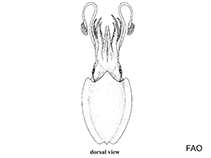Sepia peterseni Appellöf, 1886
| Native range | All suitable habitat | Point map | Year 2050 |

|
| This map was computer-generated and has not yet been reviewed. |
| Sepia peterseni AquaMaps Data sources: GBIF OBIS |
Adicionar o seu Fotografias
Imagem do Google | No image available for this species;
drawing shows typical species in Sepiidae.
Imagem do Google | No image available for this species;
drawing shows typical species in Sepiidae.
Classification / Names Common names | Synonyms | CoL | ITIS | WoRMS
| Sepiida | Sepiidae
Environment: milieu / climate zone / depth range / distribution range Ecologia
Associadas(os) a recifes; intervalo de profundidade 20 - 100 m (Ref. 1695). Temperate; 46°N - 23°N, 123°E - 149°E
Distribuição Países | Áreas FAO | Ecossistemas | Ocorrências | Introduções
Southwest Pacific: from Japan to South Korea.
Length at first maturity / Tamanho / Peso / Idade
Maturity: Lm ? range ? - ? cm Max length : 12.0 cm ML macho/indeterminado; (Ref. 1695)
Life cycle and mating behavior Maturidade | Reprodução | Desova | Ovos | Fecundidade | Larvas
Members of the class Cephalopoda are gonochoric. Male and female adults usually die shortly after spawning and brooding, respectively. Mating behavior: Males perform various displays to attract potential females for copulation. During copulation, male grasp the female and inserts the hectocotylus into the female's mantle cavity where fertilization usually occurs. Life cycle: Embryos hatch into planktonic stage and live for some time before they grow larger and take up a benthic existence as adults.
Referência principal
Referências | Coordenador | Colaboradores
Jereb, P. and C.F.E. Roper (eds.). 2005. (Ref. 1695)
Categoria na Lista Vermelha da IUCN (Ref. 130435)
Dados insuficientes (DD) ; Date assessed: 24 March 2009
Categoria CITES (Ref. 108899)
Not Evaluated
CMS (Ref. 116361)
Not Evaluated
Ameaça para o homem
Utilização humana
| FishSource |
Ferramentas
Mais informação
Idade/Tamanho
Crescimento
Comprimento-peso
Comprimento-comprimento
Morfologia
Larvas
Abundância
Crescimento
Comprimento-peso
Comprimento-comprimento
Morfologia
Larvas
Abundância
Fontes da internet
BHL | BOLD Systems | CISTI | DiscoverLife | FAO(Publication : search) | Fishipedia | GenBank (genoma, nucleotídeo) | GloBI | Gomexsi | Google Books | Google Scholar | Google | PubMed | Árvore da vida | Wikipedia (ir para, procurar) | Registo zoológico
Estimates based on models
Preferred temperature
(Ref. 115969): 11.7 - 20.9, mean 17.5 (based on 20 cells).



